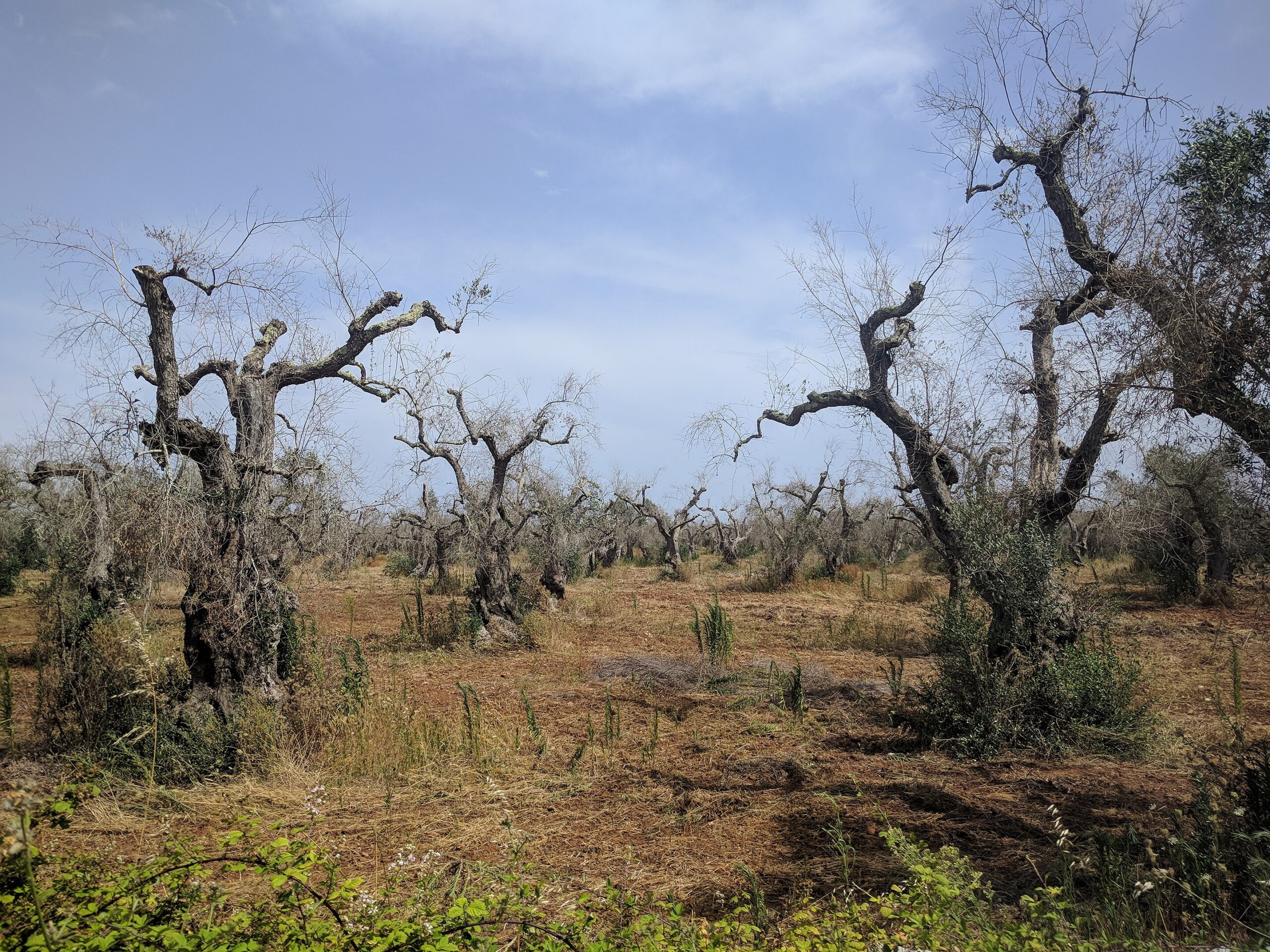Olive trees, iconic to Mediterranean landscapes and integral to Italy’s agricultural heritage, are under severe threat from a bacterial pathogen known as Xylella fastidiosa. First identified in the Apulia region in 2013, this bacterium has caused extensive economic and ecological damage to olive groves. As a biologist specializing in plant diseases in Italy, this guide aims to offer a thorough understanding of Xylella fastidiosa, including detection, management, and prevention strategies for affected olive trees.
Xylella fastidiosa is a xylem-limited bacterium primarily transmitted by xylem-feeding insects such as the meadow spittlebug (Philaenus spumarius). It obstructs the xylem vessels, impairing the transport of water and nutrients within the plant. This blockage leads to symptoms such as leaf scorch, wilting, and eventual dieback, a condition known as Olive Quick Decline Syndrome (OQDS) when it affects olive trees.
Early Detection and Symptoms
Early detection of Xylella fastidiosa is crucial for effective disease management. Symptoms to watch for include leaf scorch, where leaves develop a burnt appearance with brown edges; wilting of branches and leaves, particularly in dry conditions; dieback of twigs and branches, starting from the tips; and stunted growth, resulting in reduced yield and overall plant vigor. If these symptoms are observed, prompt action is essential.
To confirm the presence of Xylella fastidiosa, begin with a thorough visual inspection of the tree for the aforementioned symptoms. For definitive confirmation, laboratory testing is required. This involves collecting samples of symptomatic leaves, twigs, and branches and sending them to a certified plant pathology lab. Techniques such as Polymerase Chain Reaction (PCR) are commonly employed for accurate detection.
No Cure: Immediate Remedial Actions
As of now, there is no known cure for Xylella fastidiosa. However, several treatments and management strategies can help mitigate its impact. Once Xylella fastidiosa is confirmed, several immediate actions should be taken to mitigate the disease’s spread and impact. First, isolate the affected trees by marking them and establishing a buffer zone to prevent transmission to healthy trees. Next, remove and destroy infected branches to reduce the bacterial load, though this measure may only be temporary and may not save severely infected trees. Additionally, controlling the population of xylem-feeding insects is crucial, as they are the primary vectors. Use insecticides judiciously and consider introducing natural predators to help manage the vector population.
For long-term management, eradication may be necessary in areas where Xylella fastidiosa is not yet widespread. This involves the complete removal and destruction of infected trees to eliminate the disease. Adhering to local and national quarantine regulations is also important to prevent the movement of potentially infected plant material and vectors. Implementing strict phytosanitary measures is essential to control the disease’s spread. Moreover, research and cultivation of olive tree varieties that exhibit resistance to Xylella fastidiosa, such as Leccino and FS-17, can provide a valuable defense against the pathogen.
New Hope
A sliver of hope has emerged for olive growers in Apulia, Italy. While the devastating Xylella fastidiosa bacterium continues to plague olive trees, some infected trees are showing signs of recovery following new treatment approaches. However, the European Food Safety Authority (EFSA) clarifies that these treatments don’t eliminate the pathogen entirely; instead, they improve the health and resilience of the trees.
Xylella fastidiosa, particularly the CoDiRO strain, has been responsible for the rapid decline and death of olive trees across the Apulia region. The EFSA was tasked by the European Commission to assess the effectiveness of various treatment solutions in eliminating the bacteria from infected plants.
Experimental Treatment
The scientific body reviewed research from two separate groups in Italy: professors Carlucci and Lops from the University of Foggia and Professor Scortichini from CREA (Fruit Tree Research Unit, Caserta). These researchers have been conducting field trials using a combination of methods, including commercially available fertilizers, fungicides, and bioactive compounds. Micronutrient formulations containing zinc (Zn) and copper (Cu), sometimes with citric acid, were also explored. Additionally, the trials incorporated rigorous agronomic practices such as pruning, soil cultivation, weed control, and irrigation management.
While all treated trees still tested positive for Xylella fastidiosa, both research groups reported promising results. Treated trees displayed increased foliage and new branch growth compared to untreated controls, indicating improved tree vigor. In some cases, treated trees even produced a sizable olive harvest, a welcome sign for struggling growers. Professor Scortichini’s trials using Zn, Cu, and citric acid yielded another positive outcome: the treated trees reportedly survived harsh summer and winter conditions, suggesting increased resilience.
Findings are Preliminary
The EFSA Panel on Plant Health (PLH) emphasizes that these findings are preliminary. They acknowledge the positive impact on tree health but caution that the treatments don’t eliminate Xylella fastidiosa from the plant tissues. Additionally, long-term effectiveness remains undetermined, and further multi-year studies are necessary. The panel also highlights the need for more data to isolate the specific effects of each treatment within the combined approaches.
Conclusion
Despite these limitations, the PLH Panel acknowledges the potential benefits of these treatment strategies. The treatments may extend the productive lifespan of olive trees in Xylella-infected areas and contribute to the management of olive orchards, particularly in containment zones. The fight against Xylella fastidiosa in Apulia continues, and while a complete cure remains elusive, these new treatment approaches offer a potential path forward for olive growers in the region.
References
- EFSA Panel on Plant Health (PLH); Scientific Opinion on the risks to plant health posed by Xylella fastidiosa in the EU territory, with the identification and evaluation of risk reduction options. EFSA Journal 2015;13(1):3989.
- European Food Safety Authority (EFSA). 2019. Update of the Xylella spp. host plant database – systematic literature search up to 30 June 2018. EFSA Journal 2019;17(5):5666.
- Saponari, M., Boscia, D., Altamura, G., D’Attoma, G., Cavalieri, V., Di Carolo, M., … & Martelli, G.P. (2017). Isolation and pathogenicity of Xylella fastidiosa associated with olive quick decline syndrome in southern Italy. Scientific Reports, 7(1), 17723.




